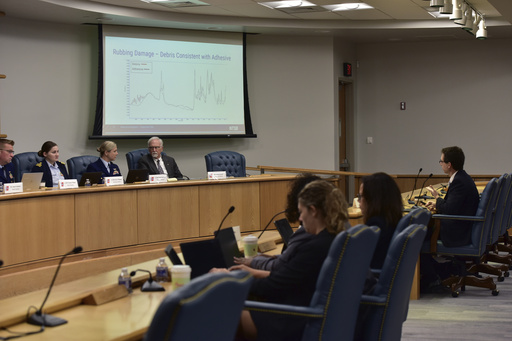OceanGate co-founder Stockton Rush said the carbon fiber hull used in an experimental submersible that imploded was developed with help of NASA and aerospace manufacturers, but a NASA official said Thursday that the agency had little involvement and a Boeing official said some recommendations were ignored.
NASA intended to play a role in building and testing the carbon fiber hull. But the COVID-19 pandemic prevented NASA from fulfilling its role, other than consulting on a one-third scale mockup, not the submersible Titan that imploded while attempting to go to the Titanic wreckage, said Justin Jackson, a materials engineer for NASA.
At one point, Jackson said NASA balked at allowing its name to be invoked by OceanGate. “The language they were using was getting too close to us endorsing, so our folks had some heartburn,” he told a Coast Guard panel.
Boeing was involved in an early feasibility study of the use of carbon fiber for Titan’s hull and in OceanGate’s acoustic sensors on the hull, but OceanGate departed from recommendations on the hull thickness and orientation of carbon fiber layers for greatest strength, said Mark Negley, material and process engineer at Boeing.
Rush was among the five people who died when the submersible imploded in June 2023.
The Coast Guard opened a public hearing earlier this month that is part of a high-level investigation into the cause of the implosion. Coast Guard officials noted at the start of the hearing that the submersible had not been independently reviewed, as is standard practice. That and Titan’s unusual design subjected it to scrutiny in the undersea exploration community.
John Winters, a Coast Guard marine inspector in Washingon state, testified that Rush railed against regulations that he said stifled innovation but also noted that Rush did not attempt to circumvent any Coast Guard regulations.
He testified Thursday that he was familiar with two other OceanGate submersibles before learning that the company had created a new submersible that could go deeper to reach Titanic. Winters said he was not aware that Oceangate ever notified the Coast Guard of its construction or requested a Coast Guard guidance or inspection.
“We didn’t get into about what standards it was built to, who built it. None of that was discussed,” Winters said. “It was just, ‘Hey, we have a submarine. It’s good for 4,000 meters. We have a submarine to do that now,’” he said.
The hearing is expected to run through Friday and include more witnesses.
Earlier in the hearing, former OceanGate operations director David Lochridge said he frequently clashed with Rush and felt the company was committed only to making money. “The whole idea behind the company was to make money,” Lochridge testified. “There was very little in the way of science.”
Lochridge and other previous witnesses painted a picture of a company that was impatient to get its unconventionally designed craft into the water. The accident set off a worldwide debate about the future of private undersea exploration.
OceanGate, based in Washington state, suspended its operations after the implosion. The company has no full-time employees currently, but has been represented by an attorney during the hearing.
During the submersible’s final dive on June 18, 2023, the crew lost contact after an exchange of texts about Titan’s depth and weight as it descended, and concern grew on the support ship Polar Prince. One of the last messages from Titan’s crew before the submersible imploded stated, “all good here,” the Coast Guard said.
When the submersible was reported overdue, rescuers rushed ships, planes and other equipment to an area about 435 miles (700 kilometers) south of St. John’s, Newfoundland. Wreckage of the Titan was subsequently found on the ocean floor about 330 yards (300 meters) off the bow of the Titanic, Coast Guard officials said. No one on board survived.
OceanGate said it has been fully cooperating with the Coast Guard and NTSB investigations since they began. Titan had been making voyages to the Titanic wreckage site going back to 2021.
This website uses cookies so that we can provide you with the best user experience possible. Cookie information is stored in your browser and performs functions such as recognising you when you return to our website and helping our team to understand which sections of the website you find most interesting and useful.
